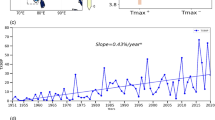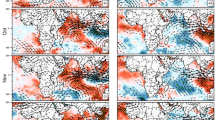Abstract
The occurrence of extreme rainfall events over mainland Mozambique associated with tropical cyclones (TC) Eline and Bonita is studied. Bonita caused catastrophic flooding in the central and some parts of northern Mozambique, thus forming the basis of the present study. Results show that the intensity of these TCs was maintained by the easterly wind from the Mascarene High. The northeasterly monsoon wind and northwesterlies from the Benguela current converged at the center of the TC, acting as a moisture source. The rainfall related to the two TCs befell in three stages and its magnitude attenuated progressively from the coastal region toward inland, concurring with the degeneration of the TCs. In stage one, for Eline, rainfall mainly concentrated in Tete, Manica, Niassa, North of Gaza provinces, the coastal Nampula, Zambezia, Sofala and Inhambane provinces. During Bonita’s inner-core circulation landfall, the northern and few parts of central Bonita were directly inundated. In the second stage, for Eline, the center of concentration of rainfall was in the central and southern parts of Mozambique. The mechanisms, including warm-air advection, vertical wind shear, could have contributed at the same time to the lifting vital for the generation of the storm during the second stage. The information herein is essential for future forecasting and monitoring of TC over the Indian Ocean. The findings form a good reference in the understanding of the recent cyclones, Kenneth and Idai that were destructive over Mozambique.













Similar content being viewed by others
Data availability
The station datasets analyzed during the current study are available from the corresponding author on reasonable request. The data on/for TRMM multi-satellite precipitation analysis (TMPA), cyclone track, and composite analysis for wind, vertical velocity, relative humidity and CAPE that support the findings of this study are available from http://disc.sci.gsfc.nasa.gov, https://www.metoc.navy.mil/jtwc/jtwc.html, and https://www.ecmwf.int/en/forecasts, respectively.
References
Ash KD, Matyas CJ (2012) The influences of ENSO and the subtropical Indian Ocean Dipole on tropical cyclone trajectories in the southwestern Indian Ocean. Int J Climatol 56:41–56. https://doi.org/10.1002/joc.2249
Barimalala R, Desbiolles F, Blamey RC, Reason C (2018) Madagascar influence on the South Indian Ocean Convergence Zone, the Mozambique Channel Trough and southern African rainfall. Geophys Res Lett 45:11380–11389. https://doi.org/10.1029/2018GL079964
Bessafi M, Wheeler MC (2006) Modulation of South Indian Ocean tropical cyclones by the Madden–Julian oscillation and convectively coupled equatorial waves. Mon Weather Rev 143:638–656. https://doi.org/10.1175/MWR3087.1
Burpee RW, Black ML (1989) Temporal and spatial variation of rainfall near the centers of two tropical cyclones. Mon Weather Rev 117:2208–2218. https://doi.org/10.1175/1520-0493(1989)117%3c2204:TASVOR%3e2.0.CO;2
Camargo SJ, Ballester M, Barnston AG, Klotzbach P, Roundy P, Saunders MA, Vitart F, Wheeler MC (2006) Short-term climate (seasonal and intra-seasonal) prediction of tropical cyclone activity and intensity. Topic 4.3, Workshop Topic Reports, Sixth International Workshop on Tropical Cyclones (IWTC-VI), San José, Costa Rica, November 2006. WMO, TMRP 72:493–499
Chen SS, Knaff JA, Marks FD Jr (2006) Effects of vertical wind shear and storm motion on tropical cyclone rainfall asymmetries deduced from TRMM. Mon Weather Rev 134:3190–3208. https://doi.org/10.1175/MWR3245.1
Chu J-H, Sampson CR, Levine AS, Fukada E (2002) The Joint Typhoon Warning Center tropical cyclone best-tracks, 1945–2000. Naval Research Laboratory, Washington, p 22 (NRL/MR/7540-02-16)
Dare RA, Davidson NE, Mcbride JL (2012) Tropical cyclone contribution to rainfall over Australia. Mon Weather Rev 140:3606–3619. https://doi.org/10.1175/MWR-D-11-00340.1
Dee DP, Uppala SM, Simmons AJ, Berrisford P, Poli P, Kobayashi S, Andrae U, Balmaseda MA, Balsamo G, Bauer P, Bechtold P, Beljaars ACM, van de Berg L, Bidlot J, Bormann N, Delsol C, Dragani R, Fuentes M, Geer AJ, Haimberger L, Healy SB, Hersbach H, Hólm EV, Isaksen L, Kållberg P, Köhler M, Matricardi M, McNally AP, Monge-Sanz BM, Morcrette J-J, Park B-K, Peubey C, de Rosnay P, Tavolato C, Thépaut J-N, Vitart F (2011) The ERA-Interim reanalysis: configuration andperformance of the data assimilation system. Q J R Meteorol Soc 137:553–597. https://doi.org/10.1002/qj.828
Demaria M, Kaplan J (1999) An updated statistical hurricane intensity prediction scheme (SHIPS) for the Atlantic and Eastern North Pacific Basins. Weather Forecast 14:326–337. https://doi.org/10.1175/1520-0434(1999)014%3c0326:AUSHIP%3e2.0.CO;2
Elsberry RL, Jeffries RA (1996) Vertical wind shear influences on tropical cyclone formation and intensification during TCM-92 AND TCM-93. Mon Weather Rev 124:1374–1387. https://doi.org/10.1175/1520-0493(1996)124%3c1374:VWSIOT%3e2.0.CO;2
Emanuel KA (1994) Atmospheric convection. Oxford University Press on Demand, Oxford
Fitchett JM, Grab SW (2014) A 66-year tropical cyclone record for south-east Africa: temporal trends in a global context. Int J Climatol 34:3604–3615. https://doi.org/10.1002/joc.3932
Gaffney SJ (2004) Probabilistic curve-aligned clustering and prediction with regression mixture models. Ph.D. Thesis, University of California, USA
Gao S, Meng Z, Zhang F, Bosart LF (2009) Observational analysis of heavy rainfall mechanisms associated with severe tropical storm Bilis (2006) after its Landfall. Mon Weather Rev 137:1881–1898. https://doi.org/10.1175/2008MWR2669.1
Gao S, Zhai S, Li T, Chen Z (2018) On the asymmetric distribution of shear-relative typhoon rainfall. Meteorol Atmos Phys 130:11–22. https://doi.org/10.1007/s00703-016-0499-0
Guard CP, Carr LE, Wells FH, Jeffries RA, Gural ND, Edson DK (1992) Joint typhoon warning center and the challenges of multibasin tropical cyclone forecasting. Weather Forecast 7:328–352. https://doi.org/10.1175/1520-0434
Ho C-H, Kim J-H, Jeong J-H, Kim H-S, Chen D (2006) Variation of tropical cyclone activity in the South Indian Ocean: El Nino-Southern Oscillation and Madden-Julian Oscillation effects. J Geophys Res 111:D22101. https://doi.org/10.1029/2006JD007289
Huffman GJ, Adler RF, Bolvin DT, Nelkin EJ (2010) The TRMM multi-satellite precipitation analysis (TMPA). In: Gebremichael M, Hossain F (eds) Satellite rainfall applications for surface hydrology. Springer, Dordrecht, Netherlands, pp 3–22. https://doi.org/10.1007/978-90-481-2915-7_1
IPCC (2018) Global warming of 1.5 °C. An IPCC Special Report on the impacts of global warming of 1.5 °C above pre-industrial levels and related global greenhouse gas emission pathways, in the context of strengthening the global response to the threat of climate change, sustainable development, and efforts to eradicate poverty [Masson-Delmotte V, Zhai P, Pörtner HO, Roberts D, Skea J, Shukla PR, Pirani A, Moufouma-Okia W, Péan C, Pidcock R, Connors S, Matthews JBR, Chen Y, Zhou X, Gomis MI, Lonnoy E, Maycock T, Tignor M, Waterfield T (eds.)]. https://www.ipcc.ch/site/assets/uploads/sites/2/2019/06/SR15_Full_Report_High_Res.pdf (Accessed 20 December 2020)
Khouakhi A, Villarini G, Vecchi GA (2017) Contribution of tropical cyclones to rainfall at the global scale. J Climate 30:359–372. https://doi.org/10.1175/JCLI-D-16-0298.1
Knaff JA, Sampson CR, Demaria M (2005) An operational statistical typhoon intensity prediction scheme for the Western North Pacific. Weather Forecast 20:688–699. https://doi.org/10.1175/WAF863.1
Knutson TR, Sirutis JJ, Zhao M, Tuleya RE, Bender M, Vecchi GA, Villarini G, Chavas D (2015) Global projections of intense tropical cyclone activity for the late twenty-first century from dynamical downscaling of CMIP5/RCP4.5 scenarios. J Climate 28:7203–7224. https://doi.org/10.1175/JCLI-D-15-0129.1
Kummerow C, Barnes W, Kozu T, Shiue J, Simpson J (1998) The tropical rainfall measuring mission (TRMM) sensor package. J Atmos Oceanic Tech 15:809–817. https://doi.org/10.1175/1520-0426(1998)015%3c0809:TTRMMT%3e2.0.CO;2
Landman WA, Seth A, Camargo SJ (2005) The effect of regional climate model domain choice on the simulation of tropical cyclone—like vortices in the Southwestern Indian Ocean. J Climate 18:1263–1274. https://doi.org/10.1175/JCLI3324.1
Lonfat M, Frank DM Jr, Chen SS (2004) Precipitation distribution in tropical cyclones using the Tropical Rainfall Measuring Mission (TRMM) Microwave Imager: A global perspective. Monthly Weather Review 132(7):1645–1660. https://doi.org/10.1175/1520-0493(2004)132%3c1645:PDITCU%3e2.0.CO;2
Malherbe J, Engelbrecht FA, Landman WA, Engelbrecht CJ (2012) Tropical systems from the southwest Indian Ocean making landfall over the Limpopo River Basin, southern Africa: a historical perspective. Int J Climatol 32:1018–1032. https://doi.org/10.1002/joc.2320
Malherbe J, Engelbrecht FA, Landman WA (2013) Projected changes in tropical cyclone climatology and landfall in the South West Indian Ocean region under enhanced anthropogenic forcing. Clim Dyn 40:2867–2886. https://doi.org/10.1007/s00382-012-1635-2
Manhique AJ, Reason CJC, Rydberg L, Fauchereau N (2011) ENSO and Indian Ocean sea surface temperatures and their relationships with tropical temperate troughs over Mozambique and the Southwest Indian Ocean. Int J Climatol 31:1–13. https://doi.org/10.1002/joc.2050
Matyas CJ (2015) Tropical cyclone formation and motion in the Mozambique Channel. Int J Climatol 35:375–390. https://doi.org/10.1002/joc.3985
Mavume AF, Rydberg L, Rouault M, Lutjeharms JRE (2009) Climatology and landfall of tropical cyclones in the South–West Indian Ocean. Western Indian Ocean J Mar Sci 8:15–36. https://doi.org/10.4314/wiojms.v8i1.56672
Mudenda OS, Mumba ZLS (2013) The unusual tropical storm of January 1996. Zambia meteorological department. EUMETSAT http://citeseerx.ist.psu.edu/viewdoc/download?doi=10.1.1.601.2986&rep=rep1&type=pdf (Accessed 10 December 2019)
Muthige MS, Malherbe J, Englebrecht FA, Grab S, Beraki A, Maisha TR, Van der Merwe J (2018) Projected changes in tropical cyclones over the SouthWest Indian Ocean under different extents of global warming. Environ Res Lett 13:065019. https://doi.org/10.1088/1748-9326/aabc60
Neumann CJ, Jarvinen BR, McAdie CJ, Elms JD (1993) Tropical cyclones of the North Atlantic Ocean 1871–1992, vol 6–2. Historical Climatology Series. NOAA, Washington, p 193
Nyongesa AM, Zeng G, Ongoma V (2020) Non-homogeneous hidden Markov model for downscaling of short rains occurrence in Kenya. Theor Appl Climatol 139:1333–1347. https://doi.org/10.1007/s00704-019-03016-2
Rakotobe ZL, Harvey CA, Rao NS, Dave R, Rakotondravelo JC, Randrianariso J, Ramanahadraya S, Andriambolantsoa R, Razafimahatratra H, Rabarijohn RH, Rajaofara H, Rameson H, MacKinnon JL (2016) Strategies of smallholder farmers for coping with the impacts of cyclones: a case study from Madagascar. Int J Disast Risk Reduct 17:114–122. https://doi.org/10.1016/j.ijdrr.2016.04.013
Reason CJC, Keibel A (2004) Tropical cyclone eline and its unusual penetration and impacts over the Southern African mainland. Weather Forecast 19:789–805. https://doi.org/10.1175/1520-0434(2004)019%3c0789:TCEAIU%3e2.0.CO;2
Salazar-Espinoza C, Jones S, Tarp F (2015) Weather shocks and cropland decisions in rural Mozambique. Food Policy 53:9–21. https://doi.org/10.1016/j.foodpol.2015.03.003
Silva JA, Matyas CJ (2014) Relating rainfall patterns to agricultural income: implications for rural development in Mozambique. Weather Clim Soc 6:218–237. https://doi.org/10.1175/WCAS-D-13-00012.1
Silva JA, Matyas CJ, Cunguara B (2015) Regional inequality and polarization in the context of concurrent extreme weather and economic shocks. Appl Geogr 61:105–116. https://doi.org/10.1016/j.apgeog.2015.01.015
Vitart F, Anderson D, Stockdale T (2003) Seasonal forecasting of tropical cyclone landfall over Mozambique. J Climate 15:3932–3945. https://doi.org/10.1175/1520-0442(2003)016%3c3932:SFOTCL%3e2.0.CO;2
Wilks DS (2006) Statistical methods in the atmospheric sciences, 2nd edn. Academic Press, Cambridge
WMO (2019) Reducing vulnerability to extreme hydro-meteorological hazards in Mozambique after Cyclone IDAI. WMO mission report following tropical cyclone IDAI (29 April to 7 May). WMO, Geneva
Yano J-I, Ambaum MHP, Dacre HF, Manzato A (2020) A dynamical–system description of precipitation over the tropics and the midlatitudes. Tellus a: Dyn Meteorol Oceanogr 72:1–17. https://doi.org/10.1080/16000870.2020.1847939
Acknowledgements
The first author is appreciative of the master scholarship by the Government of China through the Ministry of Commerce (MOFCOM). All authors thank their respective institutions for supporting the research.
Author information
Authors and Affiliations
Corresponding author
Additional information
Responsible Editor: Clemens Simmer.
Publisher's Note
Springer Nature remains neutral with regard to jurisdictional claims in published maps and institutional affiliations.
Supplementary Information
Below is the link to the electronic supplementary material.
Rights and permissions
About this article
Cite this article
Armando, C.J., Yu, Z., Mavume, A.F. et al. Formation and track of tropical cyclones Eline (2000) and Bonita (1996). Meteorol Atmos Phys 133, 1691–1706 (2021). https://doi.org/10.1007/s00703-021-00835-9
Received:
Accepted:
Published:
Issue Date:
DOI: https://doi.org/10.1007/s00703-021-00835-9




